|
|
|
Sort Order |
|
|
|
Items / Page
|
|
|
|
|
|
|
| Srl | Item |
| 1 |
ID:
182687
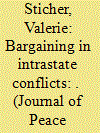

|
|
|
|
|
| Summary/Abstract |
Research shows that conflict parties engage in ceasefires in pursuit of a variety of objectives, some of which reduce while others fuel violent conflict. This article provides a framework that links these objectives to a larger process. Building on bargaining theory, three distinct bargaining contexts are specified for intrastate conflicts. In the Diminishing Opponent context, leaders believe that a military solution yields a better outcome than a political settlement. In the Forcing Concessions context, they recognize the benefit of conflict settlement, but expectations about a mutually acceptable agreement still widely diverge. In the Enabling Agreement context, expectations converge, and leaders seek to pursue settlement without incurring further costs. In line with these readings, conflict party leaders adapt their strategic goal, from seeking to set up a military advantage, to boosting their bargaining power, to increasing the chances of a negotiated settlement. They may use ceasefires in the pursuit of any of these three goals, shifting the function of a ceasefire as they gain a better understanding of bargaining dynamics. A comparison of violence and ceasefire patterns in six contemporary peace processes and a congruence test conducted on the 2012–16 peace negotiations between the Colombian government and the guerilla organization FARC offer support for the theoretical framework. The findings highlight the important, and shifting, role ceasefires play in the transition from war to negotiated peace.
|
|
|
|
|
|
|
|
|
|
|
|
|
|
|
|
| 2 |
ID:
182679


|
|
|
|
|
| Summary/Abstract |
One way nuclear agreements might keep signatories from proliferating is by constraining nuclear capacity. Theoretical work on nonproliferation often points to such constraints as an important driver of nonproliferation success. Some have argued that, absent sufficient constraint, states with the desire and capability to proliferate will do so. Faced with more costly routes to a weapon, states subject to technological constraint may abide by the terms of the deal. This perspective poses an important empirical question: do nonproliferation agreements result in significant technological constraint in practice? This article evaluates the empirical prevalence of constraints arising from nonproliferation deals. Doing so requires (1) providing an appropriate measure of nuclear proficiency and (2) developing an estimate of the counterfactual, no-agreement capacity of states that received such agreements. This study addresses both of these points. First, new data are gathered to estimate proficiency, improving upon existing measures in the literature. Second, the generalized synthetic control method is applied to estimate counterfactual proficiency levels for the recipients of agreements. With this approach, the constraining effects of deals the United States implemented with Japan, South Korea, and Taiwan and the Declaration of Iguaçu between Brazil and Argentina are evaluated. The findings indicate that the constraining effect of these nonproliferation agreements is minimal.
|
|
|
|
|
|
|
|
|
|
|
|
|
|
|
|
| 3 |
ID:
182684
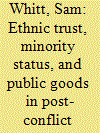

|
|
|
|
|
| Summary/Abstract |
This study considers how ethnic trust and minority status can impact the ability of ethnic groups to pursue cooperative public goods, focusing on groups with a history of conflict and lingering hostility. A public good experiment between ethnic Albanians and Serbs in postwar Kosovo reveals that subjects contribute far more to a mutually beneficial public good when they are part of an experimentally induced coethnic majority. However, when in the minority, subjects not only underinvest, but many actively divest entirely, privatizing the public good. Majority/minority status also has wide-ranging implications for how individuals relate to real-world public goods and the institutions of government that provide them. Compared to majority Albanians, survey data indicate how minority Serbs in Kosovo express greater safety and security concerns, feel more politically, socially, and economically excluded, are more dissatisfied with civil liberties and human rights protections, and are less likely to participate politically or pay taxes to support public goods. Conflict-related victimization and distrust of out-groups are strong predictors of these minority group attitudes and behaviors. This suggests a mechanism for how conflict amplifies out-group distrust, increasing parochial bias in public good commitments, especially among minorities who are wary of exploitation at the hands of an out-group majority. To restore trust, this study finds that institutional trust and intergroup contact are important to bridging ethnic divides that inhibit public good cooperation.
|
|
|
|
|
|
|
|
|
|
|
|
|
|
|
|
| 4 |
ID:
182689
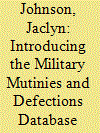

|
|
|
|
|
| Summary/Abstract |
Military mutinies are critical to scholars’ collective understanding of civil–military relations. This article introduces a new dataset that systematically codes mutinies across all regions and conducts an exploratory analysis of these new data. The primary contribution made here is the introduction of a new dataset that provides scholars with a sample of mutinies across region, space, and time. The new Military Mutinies and Defections Database (MMDD) codes events of military indiscipline from 1945 to 2017. This dataset uses geocoding techniques that will enable scholars to explore the spatial patterns and diffusion associated with mutinies. The second contribution is the preliminary exploration of these new data. Of note, I demonstrate that over one-third of all mutinies are violent, 6% of mutinies are associated with civilian deaths, and anocracies are more likely to experience mutinies than democratic or autocratic counterparts. MMDD provides investigators with an exciting new tool to explore dimensions of military disloyalty.
|
|
|
|
|
|
|
|
|
|
|
|
|
|
|
|
| 5 |
ID:
182680
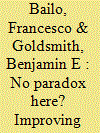

|
|
|
|
|
| Summary/Abstract |
This article contributes to both the theoretical elaboration and empirical testing of the ‘stability–instability paradox’, the proposition that while nuclear weapons deter nuclear war, they also increase conventional conflict among nuclear-armed states. Some recent research has found support for the paradox, but quantitative studies tend to pool all international dyads while qualitative and theoretical studies focus almost exclusively on the USA–USSR and India–Pakistan dyads. This article argues that existing empirical tests lack clearly relevant counterfactual cases, and are vulnerable to a number of inferential problems, including selection on the dependent variable, unintentionally biased inference, and extrapolation from irrelevant cases. The limited evidentiary base coincides with a lack of consideration of the theoretical conditions under which the paradox might apply. To address these issues this article theorizes some scope conditions for the paradox. It then applies synthetic control, a quantitative method for valid comparison when appropriate counterfactual cases are lacking, to model international conflict between India–Pakistan, China–India, and North Korea–USA, before and after nuclearization. The article finds only limited support for the paradox when considered as a general theory, or within the theorized scope conditions based on the balance of resolve and power within each dyad.
|
|
|
|
|
|
|
|
|
|
|
|
|
|
|
|
| 6 |
ID:
182683
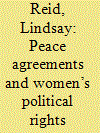

|
|
|
|
|
| Summary/Abstract |
Approximately one-quarter of civil war peace agreements contain some reference to gender, prompting the question of whether or not gender provisions within peace agreements are effective tools for improving women’s rights following conflict. As calls by the United Nations and the international community place increasing emphasis on women’s involvement in peace processes, this article generates insight into whether peace agreements, a key component of peace processes, help to spur greater political rights for women. The theoretical expectations of the article posit that peace agreements generate legal frameworks for post-conflict states. Specifically, peace agreements have the potential to tie actors’ hands to new policies and generate shifts in societal norms and practices; the direction of new policies and practices, however, is dependent on the contents of agreements. When agreements are gender-inclusive, they increase the likelihood of improvements in women’s political rights. The expectations are quantitatively tested using civil war peace agreements signed between 1981 and 2011. The findings indicate that the content of agreements matters; gender-inclusive agreements lay the foundations for improvements in women’s political rights following conflict. The article demonstrates that peace agreements, when crafted to include gender provisions, are meaningful tools that international and domestic actors can harness to strengthen women’s rights after civil war.
|
|
|
|
|
|
|
|
|
|
|
|
|
|
|
|
| 7 |
ID:
182686
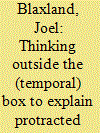

|
|
|
|
|
| Summary/Abstract |
Conflict duration has been one of the central and enduring questions driving civil war literature. Still not enough attention has been given to the interdependency of conflict duration dynamics. In an effort to bridge the gap this study introduces a new variable that positions conflict duration as a function of the duration of the pre-conflict phase. I argue proto-insurgents are able to protract conflict due to good choices made before large-scale conflict erupted – or during a period of time called ‘incubation’. After controlling for standard explanations, this study offers statistical evidence that proto-insurgent incubation duration is statistically significant and positively related to conflict duration. This study further explores the usefulness of thinking outside of the standard temporal space of wartime by moving beyond the widely accepted assumption that insurgents are empowered and constrained primarily by wartime decisionmaking and the wartime environment in which they find themselves.
|
|
|
|
|
|
|
|
|
|
|
|
|
|
|
|
| 8 |
ID:
182685
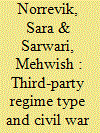

|
|
|
|
|
| Summary/Abstract |
Does the regime type of a foreign intervener influence the duration of civil wars? Existing research has shown that third-party support affects the outcome of a conflict. Moreover, studies show that the type of support offered to conflict actors can determine how a war ends. While this research has offered significant implications on conflict dynamics, extant works have overlooked the importance of characteristics of foreign supporters and how their attributes can impact conflict outcomes. Focusing on foreign troop support and quantities, this article examines the relationship between the regime type of a foreign supporter and the outcome of an armed conflict. We argue that regime type of an external troop sponsor can influence war duration based on two dynamics: selection effects and signaling effects. Specifically, troop assistance provided to warring parties by democracies decreases the length of civil wars and increases the likelihood for a one-sided victory for the supported faction. The empirical findings for all intrastate conflicts during the period 1975–2012 provide evidence for our claims that the regime type of an external intervener influences the outcome of a conflict.
|
|
|
|
|
|
|
|
|
|
|
|
|
|
|
|
| 9 |
ID:
182688


|
|
|
|
|
| Summary/Abstract |
This article introduces a new dyadic dataset measuring formal diplomatic relations. These data were coded from the Europa World Yearbook annually from 1960 to 2013 for 18,317 unique country dyads, and include the level of diplomatic representation (whether the diplomatic connection is focused on a single or multiple target countries) as well as a summary measure that captures both directed and shared dyadic level of representation. We compare the new data with data gathered previously by the Correlates of War project and find significant specific discrepancies in the period between 1970 and 1985. We then test the new data by replicating Neumayer (2008) generally validating those findings: distance, power, and ideological affinity each matter when sending and receiving formal diplomatic relations. However, using the new annual diplomatic representation data, we demonstrate a different relationship between power, affinity, and probability of diplomatic connection: dyadic foreign policy affinity is a more important driver of diplomatic exchange if both the sending and receiving countries have average relative material capabilities and matters little if one or both countries in the dyad are very powerful or very weak relative to previous model results.
|
|
|
|
|
|
|
|
|
|
|
|
|
|
|
|
| 10 |
ID:
182681
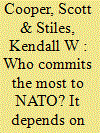

|
|
|
|
|
| Summary/Abstract |
Studies of NATO rely heavily on military spending as a fraction of GDP as the key indicator of members’ contribution to the alliance, but a growing number of scholars have challenged this approach. We suggest that each member’s public goods provision is a better measure of commitment to the alliance. In the case of post-Cold War NATO, out-of-area troop deployments (adjusted for population) constitute one of the strongest indicators of a state’s contribution to public goods. Providing troops for NATO missions in Afghanistan, Kosovo, and Bosnia-Herzegovina is one of the clearest signals of high commitment to the alliance. Using deployment data from 2004 to 2018, we show that there is evidence of disproportionate burden-sharing within the alliance. Countries like Slovenia, Denmark, the USA and UK contributed far more to NATO deployments than others like Turkey, Spain, Poland, and Portugal. We also use the data to begin examining possible causes of these disparities. We find that wealthier countries, countries that spend more on their militaries, and newer alliance members are more likely to contribute. Our indicator and first-cut model open avenues for further research on why some members demonstrate higher commitment to NATO than others.
|
|
|
|
|
|
|
|
|
|
|
|
|
|
|
|
| 11 |
ID:
182682
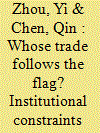

|
|
|
|
|
| Summary/Abstract |
This study revisits the association between bilateral relations and trade based on rare-event data from Integrated Data for Event Analysis (IDEA). Our results suggest that a country imports more from another if the two countries are friendlier. We further argue that states face two constraints when attempting to manipulate trade. First, they are constrained by domestic institutions such as elections and congress. Second, they are constrained by international institutions such as the World Trade Organization (WTO). Our results show that the imports of authoritarian countries follow the flag of politics, but democratic countries’ imports are less likely to be affected by bilateral relations. Moreover, WTO membership can gradually restrict democratic states from intervening on imports but has little impact on authoritarian governments.
|
|
|
|
|
|
|
|
|
|
|
|
|
|
|
|
|
|
|
|
|